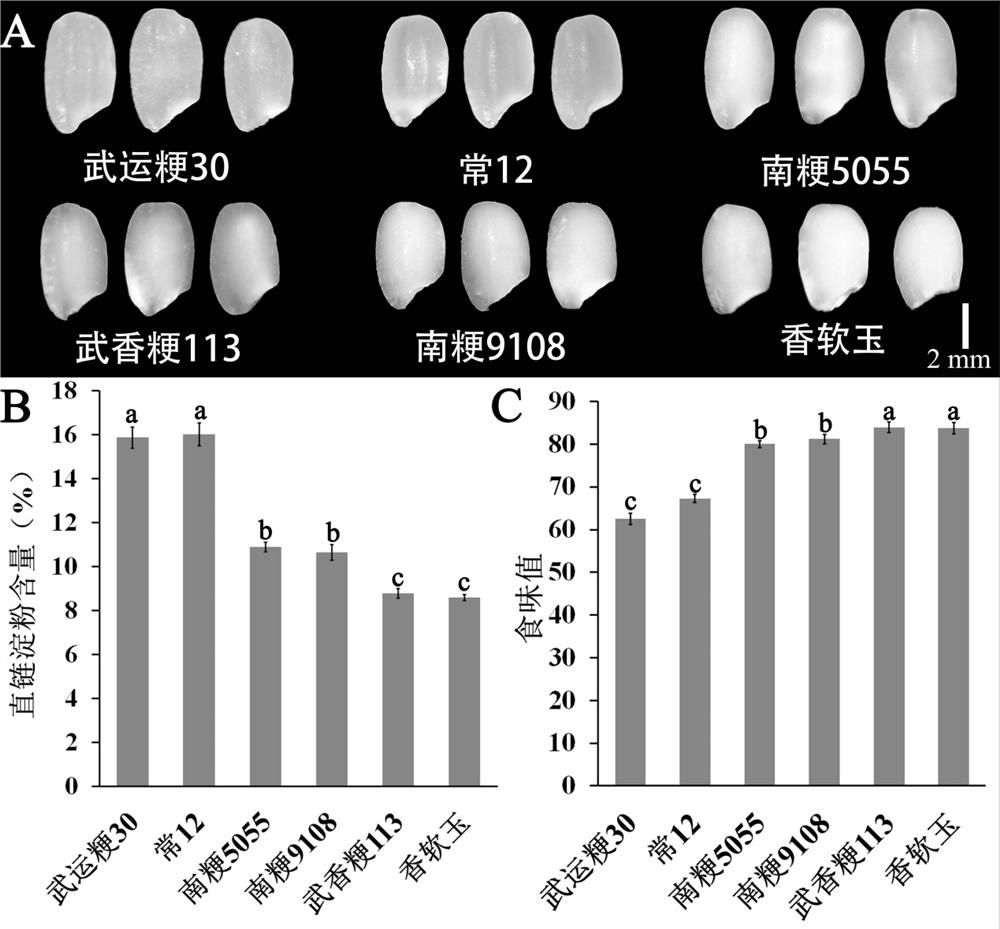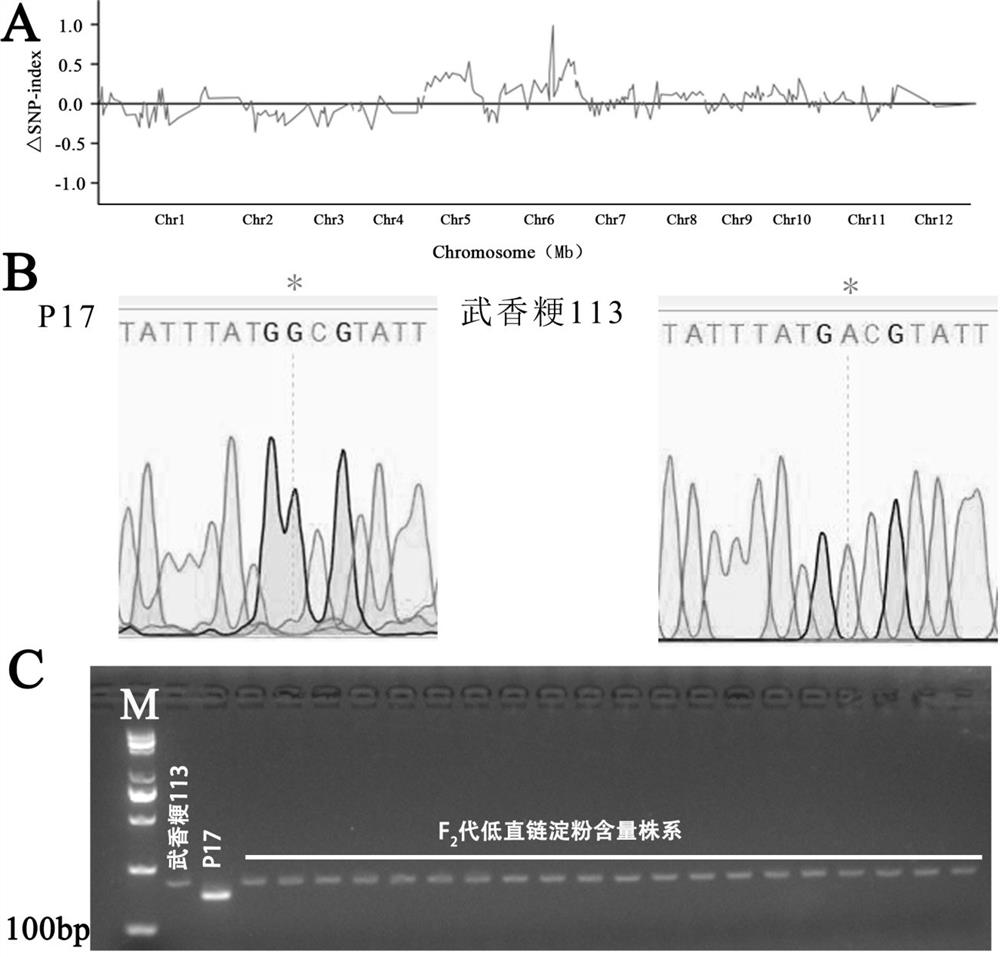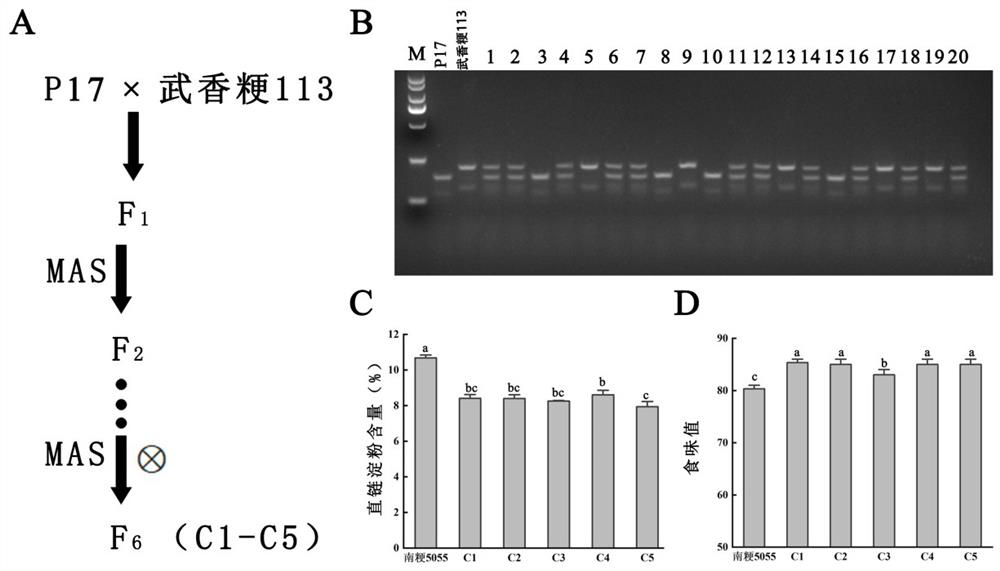DNA (Deoxyribonucleic Acid) molecular marker and method for cultivating low-amylose-content excellent-taste rice by utilizing DNA molecular marker
A DNA molecule and low-amylose technology, applied in the field of rice molecular marker-assisted selection breeding, can solve the problems of no clear information indicating new varieties, and achieve the effects of broadening available germplasm and genetic resources, good food quality, and efficient cultivation
- Summary
- Abstract
- Description
- Claims
- Application Information
AI Technical Summary
Problems solved by technology
Method used
Image
Examples
Embodiment 1
[0028] Quality Analysis of Soft Rice Varieties with Different Amylose Contents
[0029] In order to clarify the quality characteristics of soft rice with low amylose content, two representative soft rice varieties of "Nanjing" series, Nanjing 5055 and Nanjing 9108, were collected. ) Fragrant Nephrite and Wu Fragrant Japonica 113. In addition, two varieties (lines) Wuyunjing 30 and Chang 12 independently bred by the invention applicant were selected for comparative analysis of the basic quality of rice. First, the appearance quality of different varieties of rice was compared, such as figure 1 As shown in A, under the condition of natural drying, the regular japonica rice varieties Wuyunjing 30 and Chang 12 were relatively transparent in appearance, while the grain transparency of the four soft rices all showed the typical semi-waxy opaque phenotype of soft rice. The semi-waxy phenotypes of Xiangjing 113 and Fragrant nephrite rice were more pronounced than those of Nanjing 5...
Embodiment 2
[0031] Identification of regulatory loci for low amylose content and development of linked markers
[0032] In order to clarify the genetic regulation locus of low amylose content in soft rice Wuxiangjing 113, a conventional high-yielding japonica rice line P17 was selected and crossed with Wuxiangjing 113 to obtain F. 2 group. by the F 2 658 individual plants of the population were assayed for amylose content and found that F 2 In the population, there were 162 plants with low amylose content, 168 plants with high amylose content, and the others were in the middle type, indicating that the trait may be controlled by a single recessive gene. Gene segregation laws. Subsequently, 30 individual plants with extremely high amylose content and 30 extremely low amylose content were selected for deep sequencing and association analysis by mixed separation method (BSA). Based on the analysis, it was found that there are 2 linked single nucleotide polymorphism loci (SNPs) on rice ch...
Embodiment 3
[0034] Breeding of soft rice with low amylose content and good taste
[0035] In order to cultivate new lines with high yield potential and good eating quality, this scheme uses Wuxiangjing 113 and high-yielding line P17 in Example 2 to carry out continuous hybridization and carry out molecular marker-assisted selection (MAS) identification to carry the Wuxiangjing 113 genotype. the individual. For the specific hybridization process, see image 3 A. from hybrid F 2 At the beginning of the generation, using the dCAPS molecular marker Lac6-dc (sequence SEQ ID NO. 1 and SEQ ID NO. 2) closely linked with low amylose content, PCR amplification and gel electrophoresis detection ( image 3 B), from F 2 The single plant with the homozygous genotype of Wuxiangjing 113 was selected for continuous selfing in the middle generation, and 100 F4 lines were obtained. According to F 4 Comprehensive agronomic traits of the lines, from which 50 lines were selected for further selfing to ob...
PUM
 Login to View More
Login to View More Abstract
Description
Claims
Application Information
 Login to View More
Login to View More - R&D
- Intellectual Property
- Life Sciences
- Materials
- Tech Scout
- Unparalleled Data Quality
- Higher Quality Content
- 60% Fewer Hallucinations
Browse by: Latest US Patents, China's latest patents, Technical Efficacy Thesaurus, Application Domain, Technology Topic, Popular Technical Reports.
© 2025 PatSnap. All rights reserved.Legal|Privacy policy|Modern Slavery Act Transparency Statement|Sitemap|About US| Contact US: help@patsnap.com



